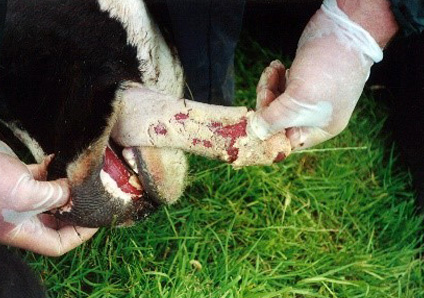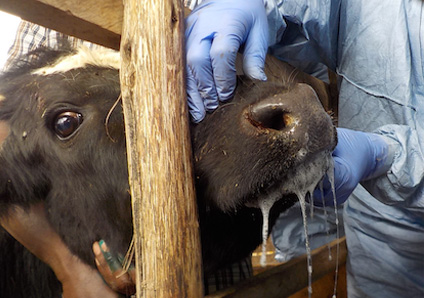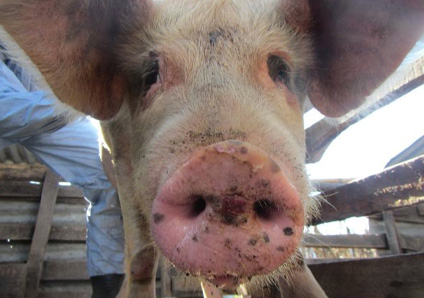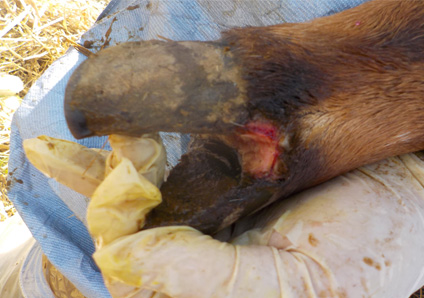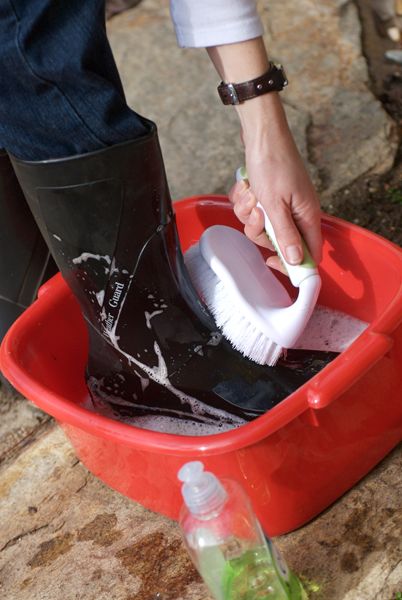If your livestock are showing signs of foot-and-mouth disease, immediately call the
Emergency Animal Disease Hotline on 1800 675 888
(free call within Australia)
Livestock producers must be alert for signs of foot-and-mouth disease (FMD) in their animals regardless of where they are in Australia. Know what symptoms to look for and keep the reporting hotline (above) handy. Use the information and links on this page to prepare your property and protect your animals.
Animals at risk of FMD
All animals with a cloven hoof (divided toe). These include:
- cattle (including buffalo)
- sheep
- goats
- pigs
- camelids (alpacas, llamas and camels)
- deer.
Clinical signs of FMD
Livestock producers, transporters and others working with at risk animals (including zookeepers and abattoir workers) need to know what the signs are in animals with FMD, including:
- blisters or ulceration where blisters have burst in and around the mouth, teats and feet
- drooling
- high temperature
- reluctance to move or lame animals.
More about the disease and how it affects animals is on our About FMD and the risk page.
How to report sick livestock
FMD is a nationally notifiable disease which means it must be reported to a veterinarian or your state/territory agriculture department. To do this, immediately call the Emergency Animal Disease Hotline on 1800 675 888. They will provide you with advice on what you need to do, and what will happen next (e.g. the collection of samples).
The Outbreak website also has advice on what to do if you suspect an emergency disease in your animals.
Our best chance of being able to contain and eradicate this disease will rely on early detection and reporting. Don’t hesitate to report. A false alarm is better than the disease going uncontained.
Prepare your property
Now is the time for livestock and property owners to put in place or review farm biosecurity practices. If you don’t have a biosecurity toolkit or plan in place for your property, now is the time to make one. The Farm Biosecurity website has free resources and information to help you.
- Create your own biosecurity toolkit
- Livestock biosecurity manuals - measures to reduce disease entering and spreading on your property, based on what you produce (includes cropping).
- Farm Biosecurity Action Planner
Farm biosecurity
There are the simple things you can do now that will help prevent disease being carried onto your property, and that will help us if there is an FMD incursion.
New or sick animals
- Inspect new stock to ensure they’re healthy.
- Isolate new stock and monitor them for signs of disease.
- Where possible, have a quarantine paddock for sick animals which is located away from boundary fences.
Visitors, vehicles and equipment
- Limit visitor entry points to your property.
- Use gate/fence signage requesting visitors to report their arrival.
- Direct visitors to designated parking areas that are away from paddocks and/or animal facilities.
- Prohibit visitors or passers-by from entering paddocks, and touching or feeding livestock.
- Wash out livestock trucks/trailers between loads – removing any manure, feed/straw etc. and clean the tyres.
- Wash and disinfect animal handling equipment.
Hygiene
- Wash and disinfect your hands before and after handling livestock.
- Wear clean clothes and boots if you’re moving between properties.
Record keeping
Good record keeping can help us trace and stop the movement of animals, allowing for faster containment and control of the disease. It’s vital to keep records of purchases, sales and movement of livestock.
Also keep a register of visitors or worker movements, including itinerant workers (backpackers, grey nomads, shearers) who may be moving between farms and states/territories.
Don’t introduce FMD through feed
Feeding prohibited pig feed (food scraps or food waste that contains meat or that has been in contact with meat) to pigs is illegal throughout Australia. This practice is also known as swill feeding and is a high-risk pathway for FMD to infect Australian livestock.
For more information on what can and can’t be fed to pigs, see the Swill feeding fact sheet from Australian Pork.
Disease risk to Northern Australia
As well as FMD, Indonesia is also responding to an outbreak of lumpy skin disease (LSD). This is also a serious animal disease which affects cattle and buffalo, and spreads through mosquitoes, midges, biting flies and ticks. Like FMD, LSD would have significant consequences for Australia’s animal health and trade.
People in northern Australia including cattle, buffalo and pig producers, vets, hunters and local Indigenous communities need to be vigilant for these diseases and be aware of biosecurity requirements.
- Do not move live animals, meat and dairy products, untanned hides or skins, other animal products or soil between the Torres Strait Protected Zone and the Torres Strait Permanent Biosecurity Monitoring Zone or to mainland Australia without a permit and an inspection by a Department of Agriculture, Fisheries and Forestry biosecurity officer.
- Keep a watch for planes or boats in your region that may be carrying animals or animal products onboard.
- Look out for food and garbage washed up on the beach that could potentially be contaminated with FMD virus and eaten by feral pigs.
If you see any of these threats, contact a local ranger or your nearest Northern Australia Quarantine Strategy office.
What to expect if there is an FMD incursion
The response to a FMD incursion would be guided by the FMD AUSVETPLAN strategy which is the nationally agreed approach to FMD, should there be an incursion.
Depending on the nature of the incursion and how quickly it is reported and can be contained, the Australian Chief Veterinary Officer may declare a national livestock standstill initially for a period of 3 days (72 hours). Stopping the movement of all susceptible livestock is a critical response activity that will slow the disease spread, and allow authorities to conduct urgent surveillance activities and trace the movement of affected livestock.
A national livestock standstill would be considered a national emergency and announced through a range of media and other communication channels. Government agencies, livestock industries and other agricultural organisations would also provide information about the standstill directly to their members and stakeholders.
Depending on the disease situation, the standstill may be extended beyond the initial 72 hours. If a decision is made to lift the national livestock standstill, individual states and territories may choose to maintain the standstill in their jurisdiction.
Movement restrictions may also apply to products. In the case on an FMD outbreak, this may include wool and dairy products.
Information and announcements for all emergency animal disease situations are published on the Outbreak website.
The primary means of eradicating an FMD outbreak is destroying infected animals humanely (also referred to as stamping out). This is the default policy under AUSVETPLAN.
The aim of stamping out is to ensure that animals on infected farms are quarantined (to contain infection on the premises) and susceptible animals are destroyed to limit the spread of the virus.
In accordance with AUSVETPLAN, carcasses and any contaminated products would be disposed of to prevent further transmission of infection in a way that doesn’t adversely affect the environment or the community. This may include burial.
Australia has an overseas FMD vaccine bank and vaccine is available for use if there is an incursion in Australia.
FMD vaccines can reduce the susceptibility of animals to becoming infected if exposed to the virus.
Movement controls and removal of infected animals (along with other complementary control measures such as cleaning and disinfection) are essential to eradicate this disease. Vaccination can be an important tool to assist in containing and eradicating FMD, but its use may have implications for Australia regaining its FMD free status, which may affect our ability to export animals and animal products.
Download fact sheet
FMD industry fact sheet (PDF 1 MB)
FMD industry fact sheet (DOCX 159 KB)
If you have difficulty accessing these files, visit web accessibility for assistance.

